Microsoft Surface Pro 3 Review
by Anand Lal Shimpi on June 23, 2014 3:55 AM ESTThickness, Thermals and Core: Understanding how Surface Pro 3 Got so Thin
Ever since Surface RT showed up I've wanted Surface Pro but in the RT chassis. Microsoft seemed to consciously avoid any lower TDP Core processors in favor of Ultrabook SKUs, which pretty much kept Surface Pro thicker than its ARM-based counterpart. Surface Pro 3 changes everything with a rethinking of how Microsoft embraced the thermal constraints of a tablet.
Surface Pro 3 is available with one of three CPU options: a Core i3, Core i5 or Core i7. The latter two are 15W TDP parts, while the former is a 11.5W TDP/6W SDP Haswell Y SKU. Haswell Y is really designed for passively cooled form factors, but all three CPU options receive the same heatpipe and fan cooling system offered by the Surface Pro 3. In short, the Core i3 model should behave a lot more like a standard Ultrabook part (sans Turbo).

Surface Pro 2 (left) vs. Surface Pro 3 (right)

Apple iPad Air (left) vs. Surface Pro 3 (right)
Microsoft's claim to fame is the ability to build the world's thinnest device with a Core series CPU inside. At 9.1mm thick, the Surface Pro 3 is just barely thicker than last year's Surface 2 but with a full blown dual-core Haswell instead instead of a high-end phone/tablet ARM SoC. As both the Surface Pro 2 and Surface Pro 3 used 15W Haswell Ultrabook parts and Microsoft claims a performance increase over last year's model, the question is how Microsoft can reduce thickness, keep TDP the same and increase performance. The answer is simply a difference in what's acceptable from a thermal standpoint.
Here's a look at the original Surface Pro while running an hour long loop of 3DMark Ice Storm Unlimited. I chose this test in particular as it behaves as a nice balance between CPU and GPU workloads on the device:
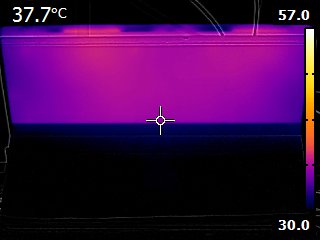
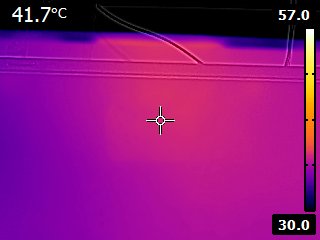
You can almost trace out the path of the heat pipe carrying the thermal load away from the CPU and to the two fans in the system. I measured peak temperature here at 41.7C.
Now let's look at Surface Pro 2:
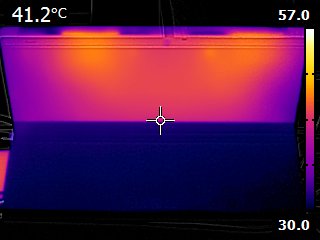
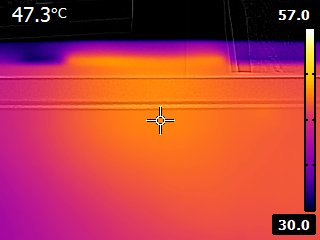
Despite a move to Haswell, Microsoft lets the device get much warmer. You can make out the same U-shape thermal distribution as heat is carried away using the two fans, but the temperatures are much higher. I measured a maximum temperature running the same workload of 47.3C.
Here we have Surface Pro 3:
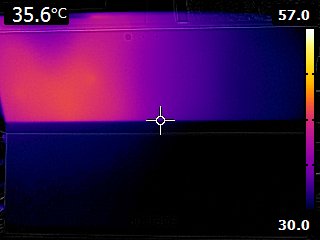
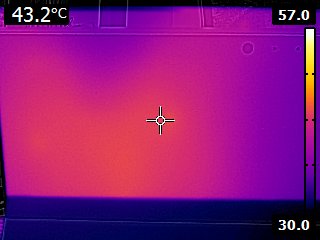
Right away you can see the new cooling system at work. The thermal load is mostly confined to the left side of the image (we are looking at the back with the kickstand unfolded towards the camera, so if you were looking at the display we're talking about the upper right side of the machine). The cooling solution is far more compact and I suspect ready for a move to Core M (Broadwell). Peak temps however are much closer to Surface Pro 1 at 43.2C.
The thermal story points us in the right direction. Either Surface Pro 3's fan and heatpipe configuration is able to remove heat far better than Surface Pro 2's design could, or the CPU in SP2 doesn't get as warm. I suspect it's the latter.
For starters, I'm guessing that Intel is helping Microsoft with delivering better binned Haswell ULT and Y series SKUs. But the big change is I believe Microsoft is more aggressive about reducing CPU and GPU frequencies in Surface Pro 3 compared to Surface Pro 2. Benchmarks will show an increase in performance due to more aggressive ramping up/down of clock speeds vs. Surface Pro 2, but prolonged load cases will likely show a decrease in performance vs. last year's model.
I first stumbled upon this behavior while trying to gather thermal data for Surface Pro 3. I noticed large run to run variance if I repeatedly ran 3DMark 11. I'm used to seeing this sort of behavior on smartphones that throttle quickly, but it was unique for a Surface Pro device.
3DMark is a synthetic test so the real question was how would Surface Pro 3 perform in a real world scenario where sustained CPU/GPU load was guaranteed for a long period of time. I figured a game playable on the machine like Dota 2 would be a great example. I asked our own Ryan Smith to whip up a custom benchmark using the game and I ran it on Surface Pro 1, 2, 3 as well as a 13-inch MacBook Air (Early 2014). The graph below illustrates average frame rate during our Dota 2 benchmark for all of the systems:
As you can see, even with Surface Pro 3's fan running the platform doesn't deliver sustained performance equal to last year's model. It's an understandable tradeoff given the substantial reduction in device thickness (and thus improvement in usability), but it's important to note nonetheless.
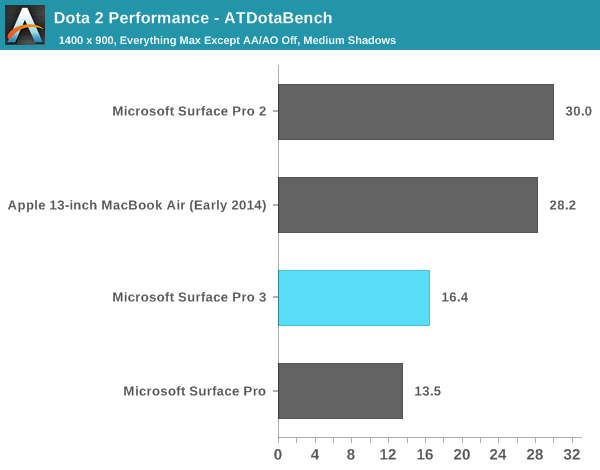
Workloads that are CPU and GPU heavy are one thing, but what about sustained productivity workloads? Penny Arcade's insanely talented artist Gabe mentioned that he noticed substantial lag when drawing on his Surface Pro 3. As Surface Pro 3's NTrig pen is actually lower latency than Surface Pro 2's, I wonder if what Gabe ran into might be thermal related rather than pen related (alternatively it could have to do with the much higher display resolution that Surface Pro 3 runs at). I needed a repeatable workload to see if non-gaming use cases also showed a regression. Thankfully PCMark 8 v2 provides a number of relatively long, repeatable workloads that are great for testing just this.
I decided to use the PCMark 8 v2 Work suite which includes web browsing, office producitivity (word processing and spreadsheet work) and video chat. It's a far cry from a Cinebench loop but I figured if I saw throttling here it would easily be present in heavier workloads. Each run of the suite actually repeats the tests three times and takes around 20 minutes to complete on the Surface devices. I measured performance for three suite runs (9 total runs of the Work loop) on both Surface Pro 2 and 3:
| PCMark 8 v2 Work Performance Over Time | |||||||
| Work Suite Run #1 | Work Suite Run #2 | Work Suite Run #3 | |||||
| Microsoft Surface Pro 3 (Core i5) | 3273 | 3031 (92% of peak) | 3129 (95% of peak) | ||||
| Microsoft Surface Pro 2 (Core i5) | 3222 | 3223 | 3218 | ||||
As you can see, there's a 9% drop in performance on Surface Pro 3 from the first suite run to the next while Surface Pro 2 delivers consistent performance between runs. By the third run Surface Pro 3's performance recovers a bit, although it's still a few percent below the initial, cool run.
PCMark 8 v2 also plots CPU temperature and frequency throughout the course of the benchmark. Unfortunately I don't think I can export the data so I'm forced to present screenshots from the benchmark harness itself. Thankfully even looking at these screenshots is enough to tell us what's going on between the two Surface Pro devices:
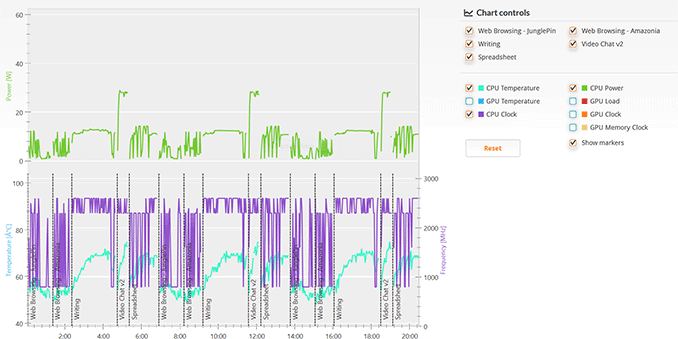
Surface Pro 2 PCMark 8 v2 Work Suite
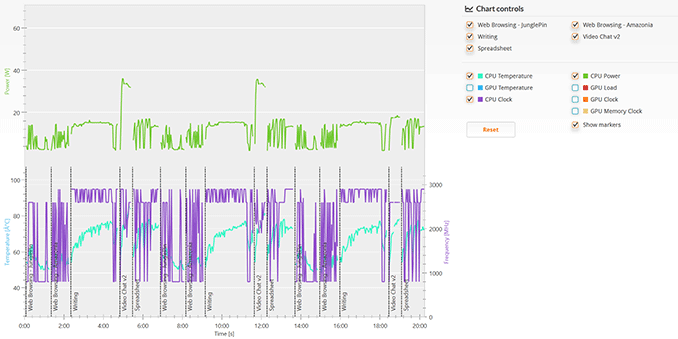
Surface Pro 3 PCMark 8 v2 Work Suite
Both devices do a good job of reaching max turbo fairly regularly, but Surface Pro 2 appears to spend more time at its max turbo state. By the last loop of the benchmark Surface Pro 3's max power is limited (green line) by the time we get to the video chat workload, I suspect that is where we lose a bit of performance. I'm only looking at the last of three suite runs here, if we looked at the second one the results would be even worse.
I haven't tested Surface Pro 3 in Microsoft's new docking station so I don't know if the device changes its thermal profile at all when docked, but in tablet or laptop mode it's definitely going to throttle quicker than Surface Pro 2 did. I must stress that I don't think this is necessarily a bad idea. Surface Pro 3 improves usability over Surface Pro 2 by leaps and bounds, and it's still faster under load than the original Surface Pro. All of this comes at the expense of reduced sustained performance. As you'll see from the rest of our tests, peak performance did get better over last year's model.
Fan Noise
Surface Pro 3's single fan is more noticeable than in Surface Pro 2. The sound it produces isn't necessarily louder, and when spinning it sounds a lot like any other Ultrabook with a fan in it. Compared to Surface Pro 2, the fan does kick in more frequently. For light tablet workloads or even light office work on Surface Pro 3, the fan remains silent. It's only when you're doing anything CPU or GPU intensive that you'll hear it spin up. The big difference is that in situations where you wouldn't hear fans spinning on Surface Pro 2, you'll sometimes hear it on SP3. This is the tradeoff that comes with the thinner chassis.










274 Comments
View All Comments
jeffkibuule - Monday, June 23, 2014 - link
30% lower power consumption, 30-40% increase in GPU performance.Morawka - Tuesday, June 24, 2014 - link
It will have either or, not both. It will either use 30% less power at the same performance (GPU included) or use the same power with a 30% increase in performance. You cant have both unless there is a new architecture, and broadwell is simply a haswell shrink.Sure they can take the power savings and add more GPU EU's but that's gonna negate the power savings.
Laxaa - Tuesday, June 24, 2014 - link
Skylake is after Broadwell, right? Maybe wait for that one?I am lookin into buying a new laptop next year, and as a graphic designer, the Surface Pro 3 looks appealing because of the pen. CPU performance seems fine for my needs, but I want lower power consumption and a better GPU(If I had to choose I'd take a better GPU) The size looks fine, and I'm not sure if I'd like it to be tinner. 9.1 mm is still pretty thin.
mkozakewich - Monday, June 30, 2014 - link
I've found that putting everything on low-power mode is still usable, but gives me an extra hour or two of battery life (on the original Surface Pro, even). Everything should be fluid enough for you with the latest one.Just make sure that issue with the edges of the screen is gone, with the move to NTrig.
Krysto - Monday, June 23, 2014 - link
Not the best laptop, not the best tablet. I think that pretty much sums up Surface in general. It's an all-compromise device.eddman - Monday, June 23, 2014 - link
You lug your laptop AND tablet around while those who are tired of it or don't have the means to do so, take an SP3.Is it really that hard to see what and who a surface pro is meant for?
name99 - Tuesday, June 24, 2014 - link
This argument only works if you're frequently in the position of having to carry both.A far more common situation is, for example, you take your laptop to school/work and use it to do laptoppy things well, an you use your table at home to do tabletty things well.
Sure if you are, for example, a journalist or traveling salesman you may be in the position of wanting to carry tablet and laptop functionality with you, and S Pro may make sense. But I think the journalist point of view (for obvious reasons) gets rather more attention on the internet than is warranted by the relevant fraction of people with these sorts of requirements.
PaulC543 - Tuesday, June 24, 2014 - link
No, the argument doesn't -only- work as you outlined, there's any number of reasons one might prefer a single device.I don't travel much, but when I do, I need a system capable of making revisions to work if need be. I have no need for the amount of text entry that would make a traditional laptop more attractive, so a tablet that could run my desktop programs was ideal. I can use it around the house for tabletty things, dock it and use it for real work, and take it when traveling to do both tabletty and work tasks.
People really need to accept that there are other use scenarios than their own. It really seems to be a mental block for the people who don't get the value of the Surface. I'm not saying the audience who do get the Surface is huge, it's clearly not, but it seems to be big enough to support Microsoft's continued development of the device, and that's all that really matters.
I don't comment on and criticize server products, because I have neither the knowledge, need or interest in the hardware that serves the market. I really wish people who don't have the knowledge, need or interest in the market the Surface serves would kindly refrain from criticizing since it's almost entirely baseless and/or misplaced.
gken8 - Tuesday, July 1, 2014 - link
let me shed light on this, the legal profession loves this tablet.ymcpa - Tuesday, June 24, 2014 - link
There is also the position where you might carry only one device but frequently find that you wish you had another device with you. For example, you might be using a laptop for work but when you go on a break, you wish you had a tablet with you to do some browsing or to watch a video. Or you are on vacation with your tablet but you get a call from work asking for some info and you wish you had your laptop with you.